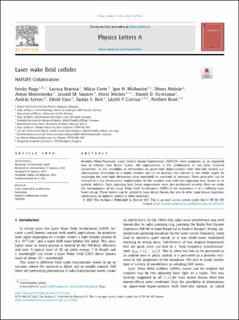| dc.contributor.author | Papp, Istvan | |
| dc.contributor.author | Bravina, L. | |
| dc.contributor.author | Csete, Maria | |
| dc.contributor.author | Mishustin, Igor N. | |
| dc.contributor.author | Molnar, Denes | |
| dc.contributor.author | Motornenko, A. | |
| dc.contributor.author | Satarov, Leonid M. | |
| dc.contributor.author | Stocker, Horst | |
| dc.contributor.author | Strottman, Daniel D. | |
| dc.contributor.author | Szenes, Andras | |
| dc.contributor.author | Vass, David | |
| dc.contributor.author | Biro, Tamas | |
| dc.contributor.author | Csernai, László Pál | |
| dc.contributor.author | Kroo, N | |
| dc.contributor.author | NAPLIFE Collaboration | |
| dc.date.accessioned | 2021-08-09T09:56:13Z | |
| dc.date.available | 2021-08-09T09:56:13Z | |
| dc.date.created | 2021-02-17T13:03:58Z | |
| dc.date.issued | 2021 | |
| dc.identifier.issn | 0375-9601 | |
| dc.identifier.uri | https://hdl.handle.net/11250/2766962 | |
| dc.description.abstract | Recently NAno-Plasmonic, Laser Inertial Fusion Experiments (NAPLIFE) were proposed, as an improved way to achieve laser driven fusion. The improvement is the combination of two basic research discoveries: (i) the possibility of detonations on space-time hyper-surfaces with time-like normal (i.e. simultaneous detonation in a whole volume) and (ii) to increase this volume to the whole target, by regulating the laser light absorption using nanoshells or nanorods as antennas. These principles can be realized in a one dimensional configuration, in the simplest way with two opposing laser beams as in particle colliders. Such, opposing laser beam experiments were also performed recently. Here we study the consequences of the Laser Wake Field Acceleration (LWFA) if we experience it in a colliding laser beam set-up. These studies can be applied to laser driven fusion, but also to other rapid phase transition, combustion, or ignition studies in other materials. | en_US |
| dc.language.iso | eng | en_US |
| dc.publisher | Elsevier | en_US |
| dc.rights | Attribution-NonCommercial-NoDerivatives 4.0 Internasjonal | * |
| dc.rights.uri | http://creativecommons.org/licenses/by-nc-nd/4.0/deed.no | * |
| dc.title | Laser Wake Field Collider | en_US |
| dc.type | Journal article | en_US |
| dc.type | Peer reviewed | en_US |
| dc.description.version | publishedVersion | en_US |
| dc.rights.holder | Copyright 2021 The Authors | en_US |
| dc.source.articlenumber | 127245 | en_US |
| cristin.ispublished | false | |
| cristin.fulltext | original | |
| cristin.qualitycode | 1 | |
| dc.identifier.doi | https://doi.org/10.1016/j.physleta.2021.127245 | |
| dc.identifier.cristin | 1890874 | |
| dc.source.journal | Physics Letters A | en_US |
| dc.relation.project | Norges forskningsråd: 255253 | en_US |
| dc.identifier.citation | Physics Letters A. 2021, 396, 127245. | en_US |
| dc.source.volume | 396 | en_US |

